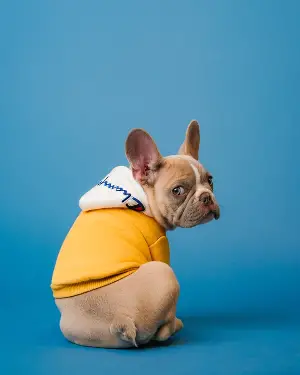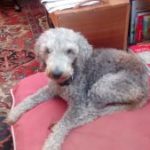
It’s almost funny to watch your dog spinning like crazy on his bottom, until you realize he’s not doing that for your amusement.
Or his.
A dog dragging his bottom in a circle on the floor is anything but amused. It’s the sign of a problem which may be more or less serious.
There’s no point in chastising the poor thing for his unusual behavior or for leaving a smelly trail of dirt on the carpet.
You need to have a look at what might be causing all that weird spinning. Here’s what you should keep in mind.
And this is exactly what you will learn in this article…
- What is scooting?
- Anal sac problems
- Fecal contamination
- Worms
- Rectal prolapse
- Why does my dog spin in circles before pooping?
- Why is my senior dog walking in circles?
- Walking in circles and vestibular problems
- Closing Thoughts
What is scooting?
When your dog is rubbing his butt against the floor it’s called scooting and it’s almost always the sign of an irritation.
This may be caused by anal sac problems, worms, a flea infestation, rectal prolapse, etc.
Let’s have a look at each of these problems.
Anal sac problems
This is the most common problem making your dog drag and rub his anus on the floor.
This type of movement provide a bit of relief for the irritation and the itchiness caused by anal sac problems.
Dogs have two anal glands located on either sides on the anus.
They are the size of a grape and cannot be observed if you stare at your dog’s behind since they’re located on the inside.
These glands release fatty smelly substances that dogs use to communicate with each other.
Every time the dog defecates, the glands emit a few drops of smelly substances.
This is the natural way a dog expresses his anal sacs.
Problems appear when he cannot do this and the glands become impacted.
Main symptoms of anal sacs problems include:
- Scooting
- Foul fishy odor coming from the dog’ butt
- Excessive licking of the anal area
- Swelling or bleeding in the anal area
- Random anal sacs leaks
If the dog has a problem with the anal glands, you will notice it. The question is what do you do about it?
Express the dog’s anal glands
Help the dog express his anal glands.
If you know the procedure and your dog trusts you you can try this at home.
If the dog has an irritated behind, it’s not a good time to go online and experiment with expressing the poor animal’s glands.
Better take him to a vet, although it’s a procedure that might cost around $100.
If there’s an infection present, the vet might also put the dog on antibiotics.
Warm compresses can also be used to provide relief and reduce irritation.
Improve your dog’s diet
There’s a very clear mechanism that allows the natural expression of the anal glands and it depends on normal well-formed stools.
If the stools are firm enough their passing through the anus will apply pressure on the sacs to express a few drops of fluid.
A dog that has loose stools cannot empty the anal sacs, which leads to inflammation and irritation. To prevent such problems in the future you need to increase your dog’s dietary fiber.
Fecal contamination
A dog might resort to scooting when there’s fecal contamination in the anal area.
This usually happens after a severe bout of diarrhea.
Fecal matter can become trapped in the hairs on the dog’s bottom.
There’s an easy way to calm your dog.
Just give him a bath and thoroughly clean the matted area on the butt.
He might not like the idea of taking a bath when he’s already annoyed by the irritation, but he will feel much better afterwards.
Use the opportunity to trim the hairs on the dog’s behind.
Once his bottom is clean take a good look at it. If it’s red and swollen, or if you see any sign of puss, that’s a sure sign the dog has developed an infection.
You can apply an antiseptic ointment, but if you don’t see any improvement in the next 24h you should take him to the vet.
The doctor will probably put the dog on oral antibiotics.
Make sure you only use ointments approved for veterinary use. If the irritation is bothering him he will lick his behind obsessively and ingest the ointment.
Worms
The culprit is usually the tapeworm.
A dog can get tapeworms by swallowing fleas infested with tapeworm eggs.
Tapeworms attach themselves to the walls of the small intestine, but as they mature individual segments, also known as proglottids, are passed with the stool.
These little segments are 1-3 mm long and look like rice grains.
It’s important to know what they look like as you might notice them wiggling around your dog’s anus.
This can be very distressing and scooting is the only way a dog can find some relief.
For starters, a quick bath will make him feel better especially if you focus on the anal area.
You should also give the dog deworming medication. Long term consider the various flea-control solutions available, including pills and topical medications.
Keep in mind that fleas can cause an allergic reaction and this alone is enough to cause skin irritations anywhere on the body, including the bottom.
Rectal prolapse
This refers to a portion of the rectum protruding from the anal opening and is as unpleasant as it sounds.
Rectal prolapse is caused by digestive problems, such as diarrhea or constipation.
Both conditions put a strain on the dog’s rectum and sometimes this makes a cylindrical mass of tissue stick out of the anus.
You need to take the dog to the vet right away.
The dog will require some stitches or even full surgery if it’s a complicated case,
Also, the vet will advise you to put the dog on a soft diet to avoid straining.
Why does my dog spin in circles before pooping?
While scooting is a sign of a problem in the anal area, spinning in circles is almost always caused by behvioral issues.
As a pet owner you know how exasperating it can be when the dog spins in circles trying to find a good position for a poop.
That’s normal behavior and certainly not meant to drive you crazy.
A dog walking in a circle and sniffing the ground is making sure the area is safe.
Squatting puts the dog in a vulnerable position, so he needs to check for predators or other hidden dangers.
Also, by flattening the grass in his chosen spot he makes sure the precious feces he’s about to deposit there will be noticeable from a distance, marking his territory.
The same goes for the bedtime ritual of many dogs.
Your pet is not being fussy when he spins in circles and stomps on his blanket.
It’s basically the same thing – making sure it’s safe for him to get some shuteye.
It’s a bit like you going around the house at night to make sure windows are all shut and the door is locked.
Why is my senior dog walking in circles?
When a senior dog develops a habit of walking in circles it might be a sign of declining brain function.
Other signs of canine cognitive dysfunction include:
- Disorientation
- Sleep disturbances
- Incontinence
- Making weird sounds
There is no cure for this age-related ailment, but the vet might prescribe medication to slow down the inevitable deterioration of the dog’s mental condition.
Monitor your dog for a couple of days and write down everything that’s relevant about this new and peculiar behavior.
Sometimes dogs spin around in a tight circle, but in some cases they walk in a very large circle, as wide as the room or the garden will allow it and it might not be easy to notice the pattern.
Spinning in circles can also be a sign of anxiety and this behavior is once again more prevalent in elderly pets.
You should see a vet about it.
Anti-anxiety medication can help in such situations, but you should also look for ways to combat the underlying problem.
Anxiety is more common in dogs who are bored.
In this case you should increase your dog’s physical exercise sessions and provide more mental stimulation.
Even offering a big bone to chew on is a way to provide mental stimulation and help him relieve anxiety.
You can also look for intelligent feeders that make him sweat to get to the treats.
In senior dogs, anxiety attacks can be triggered by the confusion caused by their declining physical abilities, like losing their sense of smell or hearing.
Walking in circles and vestibular problems
A dog that walks in circles may suffer from vestibular problems.
The vestibular system located in the inner ear helps the dog maintain balance.
Canine vestibular disease can affect dogs of all ages, but it’s more common in senior pets. It is caused by inner ear infections, certain drugs, trauma, injury or a tumor.
Other signs associated with canine vestibular disease are:
- Loss of balance
- Disorientation
- Head tilt
- Irregular jerking eye movement
You need to have the dog checked out by a vet.
An infection can easily be cured with an antibiotic, but a head trauma or a tumor might be more complicated to fix and the dog will probably need some form of surgery.
Closing Thoughts
If you notice your dog is scooting, the first thing you need to do is make a visual examination of his anal region.
Look for swelling or any type of irritation.
In most cases, this weird behavior is caused by anal sacs problems, in which case you’ll have to have his glands expressed.
The dog will need antibiotics if there’s an infection present.
When your dog walks around in circles but there’s no scooting involved, this behavior might indicate a canine cognitive dysfunction, common in senior pets, anxiety or canine vestibular disease.
If the spinning around is strictly related to the dog trying to do his business, that’s not a disease. It’s just how dogs are and you need to put up with it.
Photo credits
¹ Photo by Karsten Winegeart on Unsplash





